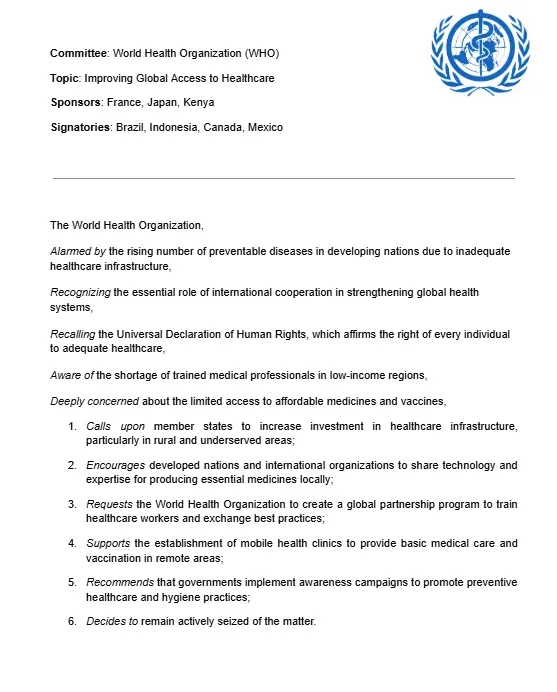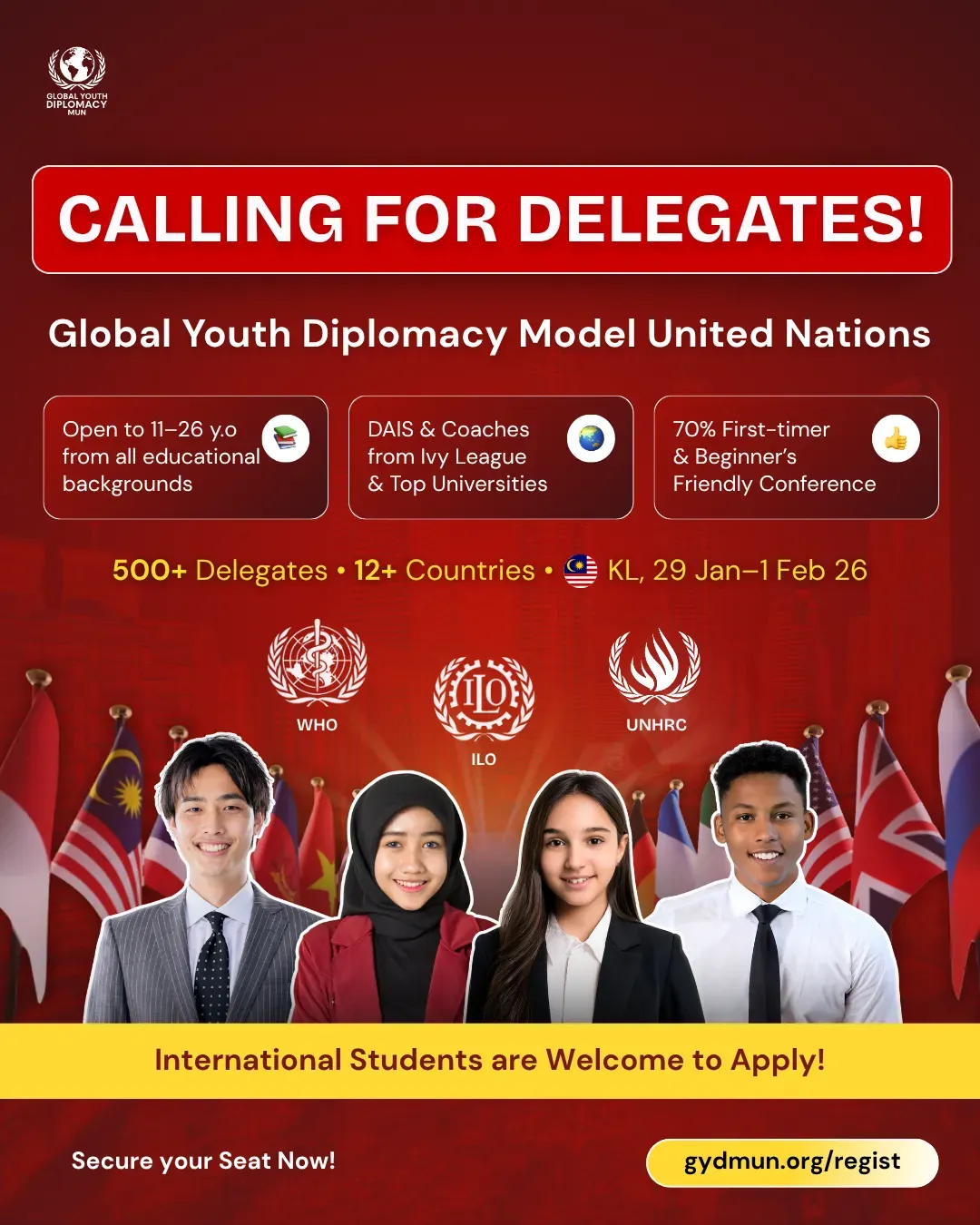Maybe you are asking, “What is a draft resolution in MUN?” Basically, a draft resolution in MUN is a formal document that outlines proposed solutions to issues being discussed in a Model United Nations committee.
It reflects the collective ideas, negotiations, and agreements reached by delegates representing different countries.
For beginners, writing a draft resolution might seem difficult at first, but it’s actually very easy once you understand the format, the topic, and the step-by-step process.
Since it serves as the foundation for debate, amendment, and ultimately the committee’s final decision, make sure you understand how to create a draft resolution in the proper format, with a sample MUN resolution paper provided!
What is a Draft Resolution in MUN?

A draft resolution in MUN is the formalized version of a working paper. While a working paper only presents ideas or discussion points informally, a draft resolution follows the official UN format and includes structured sections such as preambulatory and operative clauses.
Who typically drafts resolutions? Any delegate in the committee can write a draft resolution. The main authors are called sponsors, and most resolutions have multiple sponsors since it takes teamwork and shared perspectives to form a well-rounded proposal.
In some conferences, delegates may sponsor several resolutions for a topic, while others limit sponsorship to just one.
A draft resolution will later be discussed, debated, and amended during the committee session. If it passes the voting bloc, it officially becomes a resolution.
However, if it fails to gain enough votes, it is simply discarded or archived, meaning the committee does not adopt its proposals.
Here’s key characteristics of a MUN draft resolution:
- Written during an unmoderated caucus, where delegates collaborate and combine ideas into one document.
- Follows the UN resolution format: title, preambulatory clauses (context), and operative clauses (actions).
- Authored by one or more sponsors, often with additional signatories.
- Uses formal formatting and diplomatic language throughout.
- Usually one to two pages long, depending on topic complexity.
- Drafted through collaboration and negotiation, then submitted for debate, amendment, and voting, where it may be adopted as an official resolution or rejected.
Read More: 100+ MUN Terms You Need to Know Before Your First Conference!
Draft Resolutions Format
The very question beginners often ask is, “how to draft written resolutions?” To do so, you must first understand the draft resolution format, which includes the title, preambulatory clauses, and operative clauses.
Let’s break down the proper MUN draft resolution format, complete with examples!
1. Title or Heading
The title or heading introduces the basic details of the document and helps the committee know which issue the resolution addresses.
A proper heading typically includes the committee name, topic, sponsors, and signatories. The heading is important because it tells readers who is behind the resolution and what issue it focuses on.
Without a clear heading, delegates and chairs may confuse it with other drafts on the same topic.
Sample:
Committee: General Assembly
Topic: Strengthening International Cooperation in Climate Change Adaptation
Sponsors: France, Indonesia, Canada
Signatories: Brazil, Japan, Kenya, Germany
2. Preambulatory Clauses
Preambulatory clauses explain the background and context for the issue being addressed. They set the tone and demonstrate that the sponsors understand the problem, relevant UN actions, and international frameworks.
Each preambulatory clause starts with a present participle or adjective (e.g., Recalling, Recognizing, Deeply concerned, Guided by) and ends with a comma.
Remember, these clauses do not propose actions. Instead, they highlight why the issue matters and reference existing treaties, resolutions, or data to support the argument.
Sample:
- Deeply concerned by the increasing frequency of natural disasters caused by climate change,
- Recalling the Paris Agreement of 2015 and its commitment to limit global temperature rise,
- Acknowledging the efforts of developing countries in implementing adaptation strategies despite limited resources,
3. Operative Clauses
Operative clauses outline the solutions, actions, and recommendations proposed by the sponsors to address the issue. This section is the core of the resolution.
Each operative clause begins with an action verb (e.g., Calls upon, Encourages, Urges, Requests) and ends with a semicolon, except for the last one, which ends with a period.
These clauses should be clear, actionable, and realistic. Operative clauses may also include sub-clauses or sub-points for detailed policy suggestions.
Sample:
- Calls upon member states to strengthen regional partnerships for climate adaptation and knowledge sharing;
- Encourages developed nations to provide financial and technical assistance to developing countries for disaster preparedness;
- Requests the UN Environment Programme (UNEP) to monitor and report on the implementation of adaptation projects annually.
Draft Resolution Clauses
Clauses are the individual statements that make up the body of a MUN draft resolution. As mentioned above, there are two main types of draft resolution clauses: preambulatory clauses and operative clauses.
You must understand the difference between them and know when and how to use each one, as explained below:
1. Preambulatory Clauses
Preambulatory clauses introduce the reasoning behind the proposed actions in a draft resolution. Think of them as the “diagnosis”. They explain why the issue matters and what has been done so far.
A strong preambulatory clause should reference previous UN resolutions, international treaties, academic reports, and credible data to support the argument.
These clauses typically begin with a preambulatory verb, followed by a statement ending with a comma.
They are never numbered, and each clause should flow logically into the next to create a coherent narrative of the issue’s background.
Each preambulatory clause starts with a capitalized verb and ends with a comma (,), while the final clause before the operative section ends with a semicolon (;).
Here are some verbs commonly used in draft resolution preambulatory clauses.
Purpose | Preambulatory Verbs |
To express concern | Alarmed by, Deeply concerned, Deeply disturbed, Deeply regretting, Fully alarmed, Further deploring, Noting with deep concern, Noting with regret |
To show awareness | Aware of, Bearing in mind, Fully aware, Keeping in mind, Observing, Recognising, Taking into account, Taking into consideration, Taking note, Noting further, Pointing out |
To express belief | Believing, Confident, Convinced, Deeply convinced, Fully believing, Guided by, Realising |
To reference past actions | Having adopted, Having considered, Having examined, Having studied, Having heard, Having received, Recalling, Referring, Reminding, Reaffirming |
To show appreciation | Approving, Noting with appreciation, Noting with approval, Noting with satisfaction, Viewing with appreciation, Welcoming |
To express intention | Declaring, Desiring, Emphasising, Expecting, Fulfilling, Seeking |
2. Operative Clauses
Operative clauses contain the recommendations and calls to action that the committee wishes to implement.
Each clause should focus on a single, realistic action such as establishing a program, promoting cooperation, or allocating resources.
They should follow a logical order that moves from broad objectives to specific measures. To maintain clarity, delegates should apply the “Five Ws” rule (Who, What, When, Why, and hoW) and include details such as data, responsible parties, and timelines.
Complex measures can be divided into subclauses labeled (a), (b), (c), and so on, to make them easier to understand.
Each operative clause begins with a numbered point and a capitalized verb, ending with a semicolon (;), while the final clause ends with a period (.).
Here is a list of common operative verbs used in a MUN draft resolution operative clauses.
Purpose | Operative Verbs |
To decide | Accepts, Approves, Affirms, Confirms, Declares accordingly, Reaffirms, Solemnly affirms, Have resolved |
To call for action | Calls, Calls upon, Requests, Urges, Encourages, Further invites, Further requests |
To recommend | Recommends, Considers, Further recommends, Further resolves, Endorses, Supports |
To express appreciation | Congratulates, Expresses its appreciation, Expresses its hope, Takes note of, Notes |
To condemn | Condemns, Strongly condemns, Deplores, Regrets |
To emphasize | Draws the attention, Emphasises, Designates, Proclaims, Further proclaims |
To manage procedure | Authorises, Transmits, Further reminds, Reminds |
Read More: How to Write a Winning MUN Position Paper + Sample (Complete Guide)
How to Write Draft Resolutions for MUN
Now that you understand the basics, including the format and the different types of clauses, it is time to learn how to write a MUN draft resolution so that you are better prepared when participating in a real Model UN conference.
1. Begin with the Heading
Start your draft resolution with the heading. This section identifies which committee you’re in, what topic you’re discussing, and who helped write or support the document.
Some conferences might have specific order or format rules, so always check their guidelines. The resolution number is usually added by the chair, not you.
Make sure all sponsors and signatories have agreed to be included. Always list countries alphabetically for neatness.
Your heading should include:
- Committee name, the UN body or council.
- Topic, the subject being debated.
- Sponsors, the main authors of the resolution.
- Signatories, delegates who support discussing the resolution, even if they may not fully agree with it.
Example:
Committee: World Health Organization
Topic: Combating the Spread of Infectious Diseases
Sponsors: Japan, Brazil, Nigeria
Signatories: France, Canada, Kenya, Indonesia
2. Write the Preambulatory Clauses
Next, write the preambulatory clauses, which explain why your committee is addressing the issue in the first place.
Begin with an italicized preambulatory verb such as Alarmed by, Recognizing, or Aware of. Then, follow the verb with your explanation or evidence (for example, cite UN reports, international treaties, or global statistics that support your point).
End each clause with a comma (,) instead of a semicolon or period, and make sure you do not number them.
Use only a few strong clauses rather than many repetitive ones. This keeps your resolution clear and persuasive.
Examples:
- Alarmed by the rapid increase of infectious diseases in developing countries due to limited healthcare access,
- Recognizing the lack of affordable medicines and trained healthcare professionals in rural areas,
- Aware of the unequal distribution of vaccines between developed and developing nations,
- Recalling previous World Health Organization (WHO) initiatives aimed at strengthening public health systems,
- Deeply concerned about the rising mortality rates caused by preventable diseases,
3. Continue with the Operative Clauses
Now that you have explained the issue through your preambulatory clauses, it is time to outline your proposed solutions.
Begin each operative clause with a number (1, 2, 3, and so on). Start your statement with a strong operative verb, such as Calls upon, Encourages, Requests, or Supports.
End every clause with a semicolon (;), except for the final one, which should end with a period (.).
Examples:
- Calls upon developed nations to share medical technology and vaccines with low-income countries;
- Encourages member states to fund regional healthcare programs focused on disease prevention;
- Requests the World Health Organization to coordinate training workshops for healthcare workers.
4. Add a Concluding Clause
To wrap up your MUN draft resolution, end with a concluding clause that formally closes the document.
Although it is not mandatory, adding this final line gives your resolution a polished and professional touch, similar to real UN documents.
Most resolutions use the classic UN phrase:
Decides to remain actively seized of the matter.
This simple statement indicates that the committee acknowledges the importance of the topic and will keep addressing it in future sessions.
5. Review and Submit
Once your draft resolution is complete, it’s time to polish and prepare it for submission. Begin by reviewing every detail carefully.
Check that your punctuation is correct. Make sure your numbering is in order and that your ideas flow logically from the background to the solutions.
After reviewing, you’ll need to submit your MUN draft resolution to the committee chair or dais. They will check if it meets the formal requirements before it can be introduced for debate.
Once approved, your resolution will enter the voting bloc, where delegates discuss, amend, and finally vote on it.
MUN Draft Resolution Sample
Now that you know how to do a resolution for MUN, don’t forget to check out the sample Model UN draft resolution PDF below.
Keep in mind that this MUN draft resolution example is intentionally brief and simplified. Real resolutions are usually longer and more detailed, depending on the committee and topic.

Want to Make Your Voice Heard in a Resolution? Join GYDMUN 2026 in Malaysia!
Drafting a resolution is a powerful way to get your voice heard on international issues. Opportunities like this don’t come every day, but fortunately, Global Youth Diplomacy Model United Nations (GYDMUN) 2026 is now open for registration!

Even if you are a beginner, GYDMUN gives you the opportunity to participate in a real MUN experience.
The event will take place from 29 January to 1 February 2026 in Kuala Lumpur, Malaysia, spanning 4 days and 3 nights.
Participants aged 11–26 can join one of the three different committees: UNCHR, WHO, and ILO. You don’t need to worry about accommodation, as hotel, meals, and a city tour are all provided.
This is also a fantastic opportunity to network with over 500 delegates from around the world and collaborate on solutions to global issues.
Learn more about GYDMUN:
- Guidebook: GYDMUN Guidebook
- Video Trailer: GYDMUN 2026
- Official Website: gydmun.org
Register for GYDMUN 2026 now and start shaping the future!

References:
Model UN Made Easy: How to Write a Resolution | Best Delegate
